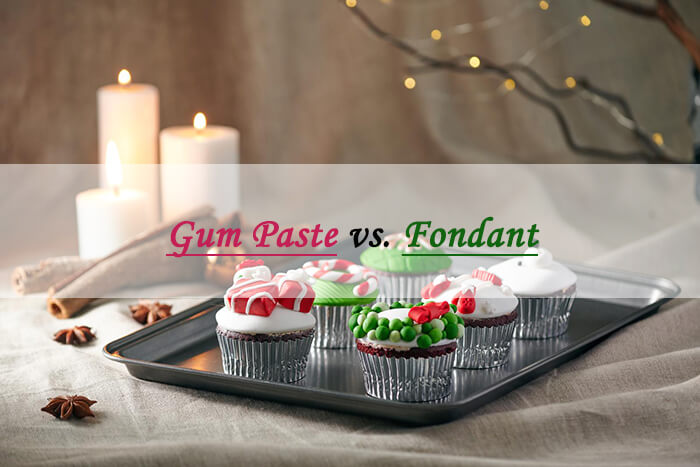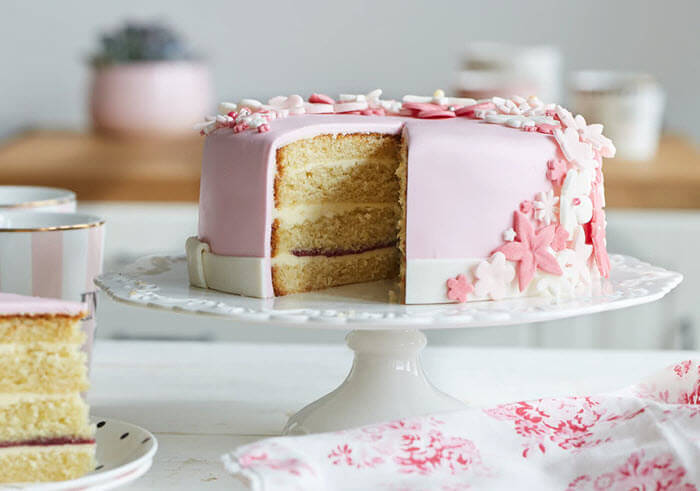When it comes to cake decorating, choosing between gum paste and fondant can be challenging, especially for beginners.
Gum Paste vs. Fondant: 10-Second Summary
The primary difference is more apparent once these doughs dry out.
While fondant does crust a bit when exposed to the air, it will stay soft and chewy on the interior.
Gum paste dries completely hard and typically only serves as a decoration rather than an edible component of the cake.
Table Of Contents
Facts About Gum Paste
What is Gum Paste
Gum paste, sometimes called florist paste or pastillage, is a dough-like cake decorating material made with egg whites, powdered sugar, gum powder, and vegetable shortening.
While technically edible, gum paste does not have any distinct taste.
The dough is pliable when fresh, with a texture similar to modeling clay, and rolls out paper-thin without tearing. Once dry, gum paste is hard and brittle, similar to porcelain.
What to Use Gum Paste for
Because of its versatility and durability, gum paste is ideal for:
- Realistic figurines
- Weight-bearing elements
- Intricate detailing
- Lifelike florals
- Ruffles and pleats
- Leaves
- Molds, presses, and stamps
- Bows, ribbons, and cascades
Facts About Fondant
What is Fondant
Fondant is a popular confectionary modeling dough that maintains its soft, pillowy texture. It consists of gelatine, water, corn syrup or glucose, glycerine, shortening, powdered sugar, and flavor extracts like vanilla or almond.
It’s often referred to as rolled fondant to differentiate it from poured fondant, the latter of which is a very soft, liquid icing that dries to a glossy finish.
Fondant is somewhat finicky and prone to tearing, cracking, and sagging. Moisture is also a big issue, as the fondant will dissolve if exposed to frostings or fillings with high liquid content.
What to Use Fondant for
Bakers often use fondant over a buttercream icing crumb coat to create a smooth, satiny canvas that remains semi-soft and chewy.
Thanks to its high sugar content, it’s very sweet and can take on complementary flavors to enhance the cake’s taste.
In addition to covering entire cakes, fondant also performs well in specific sculpting applications:
- Stamping and quilting
- Large, flat decorations such as stripes or polka dots
- Non-standing, simple figurines
- Simple shapes
- Trimmings around the bottom of cake tiers
- Cut-outs
Differences Between Gum Paste and Fondant
Let’s go more in-depth about gum paste vs. fondant, including the key ingredients and how to work with these cake shop staples.
Differences | Fondant | Gum Paste |
Key Ingredients | Glycerine and gelatine | Gum powder |
Reaction to Humidity | Sensitive to humidity | Remains hard in humid conditions |
Taste and Texture | Soft, vanilla-flavored | Bland and hard |
Storage | Lasts 2-3 days on a cake | Stay longer |
Uses | Better for simple shapes | Better for intricate details |
1. Key Ingredients
It seems counterintuitive that gum paste and fondant have distinct differences despite their strikingly similar recipes.
Thus, their unique characteristics come down to three key ingredients: glycerine and gelatine in fondant and gum powder in gum paste.
Fondant
Glycerine is a humectant [1] that acts as a moisture magnet and attracts water from the environment. For that reason, fondant stays soft and edible.
The gelatine in fondant gives it sculptability and enough stiffness to hold its shape.
Gum Paste
Gum paste, on the other hand, relies on a natural or synthetic gum powder to harden. Natural gum powders are cellulose derivatives, a chemical in plant cell walls, but synthetic versions are also available.
These gum powders are available under many names, including tragacanth, tylose, CMC [2], and GumTex.
2. Reaction to Humidity
Fondant
Fondant is quite sensitive to humidity, leaving it susceptible to drooping or tearing even after it develops an outer crust.
It’s not uncommon to hear bakers lament humid weather when working with fondant because the natural moisture in the air renders it far too soft to work with effectively.
Gum Paste
Once gum paste is dehydrated, it remains hard even in humid conditions. You can paint, sand or airbrush dried gum paste creations as if they were cured clay.
3. Taste and Texture
Fondant
Soft and marshmallowy fondant is meant to be eaten along with the cake. It’s very sweet and often vanilla-flavored, though bakers will add other extracts to achieve a particular taste.
Gum Paste
Gum paste is only intended as a decorative element on the cake. It is very bland and, once hardened, virtually impossible to bite through.
4. Storage
Fondant
Unused fondant keeps at room temperature for up to two months, so long as it is in an airtight container. If unused fondant does harden, bakers often use glycerine or shortening to soften it again.
Once it is on a cake, fondant only lasts 2-3 days. Eventually, it will dry out until it is unpleasant to chew or absorb too much moisture from the cake and fall apart.
Gum Paste
Gum paste also requires an airtight container and a surface coating of shortening to keep it from hardening. Once gum paste decorations have fully cured, typically in 24-48 hours, they retain their brittleness indefinitely.
Therefore, professional bakers often make frequently requested gum paste flowers in bulk, then store them to use as needed.
5. Uses
Both types of confectionary sculpting doughs are versatile options for creating decoration pieces, and with the right tools, your imagination is the only limit to your cake creations.
Gum Paste
Gum paste works better for standing 3D designs, intricate details, and realistic textures. It’s the go-to option for hand modeling incredibly lifelike flowers and large cake toppers.
Fondant
Fondant is perfect for simple shapes, cut-outs, stripes, and quilting. Many decorators also cover their cake boards in fondant designs to serve as a thematic backdrop.
The main thing to remember when comparing fondant and gum paste is that only fondant works when covering an entire cake. Gum paste will harden to the point that you won’t be able to get a knife through it.
FAQs About Gum Paste and Fondant
Still not sure whether you should use gum paste vs. fondant for your next cake project? These frequently asked questions can help you decide.
Which is better: Gum paste or fondant?
Neither gum paste nor fondant is better than the other. They just serve different purposes.
Gumpaste is better for long-lasting, resilient detail work and figure sculpting, while rolled fondant is better for larger elements and creating a canvas over buttercream icing.
Is it easier to work with gum paste or fondant?
Gum paste and fondant are soft, flexible doughs that roll out easily. Many pro cake decorators prefer working with gum paste, though, as it is less likely to tear even when rolled into very thin sheets.
Can you mix gum paste and fondant?
Yes! You can stiffen your fondant by kneading in an equal measure of gum paste. While it won’t dry as hard as gum paste on its own, it will be more durable and hold onto details better.




Dear Jennifer,
I visited this page with attention, I am decided to use Gum paste for my flowers , it is suitable for my hobby, but I want to know more about Gum powder , because I’m living in Iran , what is itand if I don’t find this powder , what can I use instead of it.
Thanks so much for your information & kind reply
Farineh from Iran